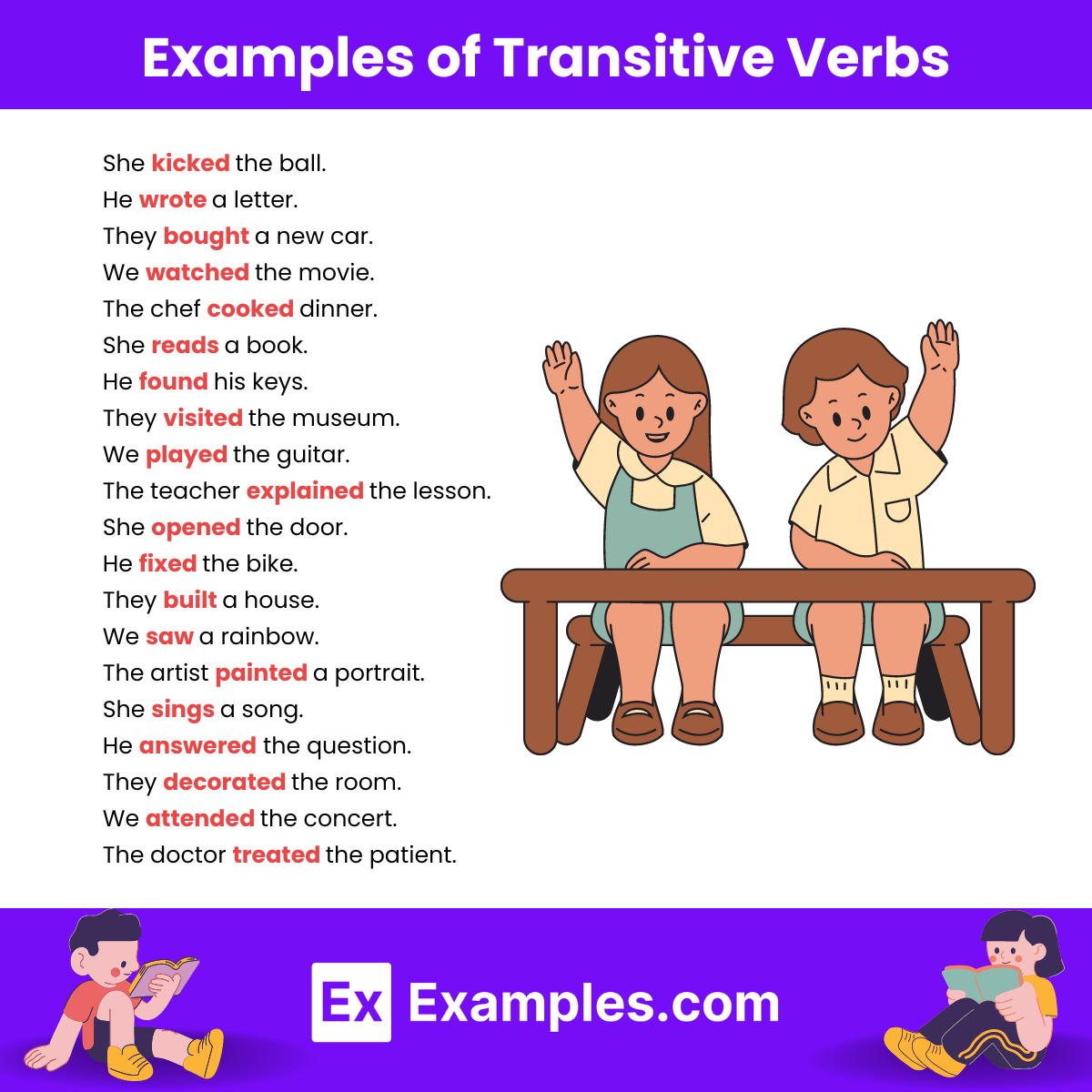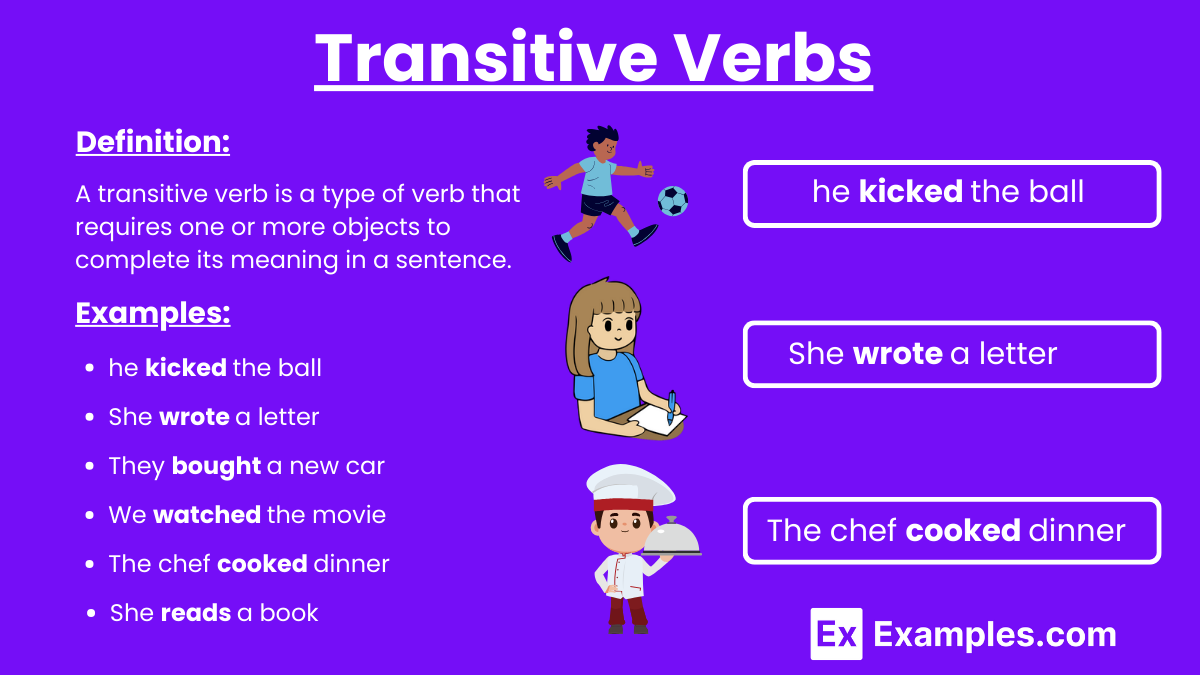60+ Transitive Verb Examples
A transitive verb is a type of action verb that requires one or more objects to receive the action. In other words, the action of the verb is transferred to a person or thing, known as the direct object. For example, in the verb sentence “She kicked the ball,” “kicked” is a transitive verb and “ball” is the direct object receiving the action. Sometimes, transitive verbs also take an indirect object, which indicates to whom or for whom the action is done, as in “She gave him a gift,” where “him” is the indirect object. Unlike intransitive verbs, which do not require an object, transitive verbs provide specific meaning and clarity by indicating who or what is affected by the action. Additionally, phrasal verbs can also be transitive, such as “give up” in “She gave up her seat,” where “seat” is the direct object.
What is a transitive verb?
A transitive verb is a type of verb that requires one or more objects to complete its meaning in a sentence. Unlike intransitive verbs, which do not need an object, transitive verbs act directly on an object, answering the questions “what?” or “whom?” For example, in the sentence “She reads a book,” the verb “reads” is transitive because it acts on the object “a book.” Transitive verbs are essential in providing clarity and detail to sentences by specifying what action is being performed and on what or whom.
Examples of Transitive Verbs

- She kicked the ball.
- He wrote a letter.
- They bought a new car.
- We watched the movie.
- The chef cooked dinner.
- She reads a book.
- He found his keys.
- They visited the museum.
- We played the guitar.
- The teacher explained the lesson.
- She opened the door.
- He fixed the bike.
- They built a house.
- We saw a rainbow.
- The artist painted a portrait.
- She sings a song.
- He answered the question.
- They decorated the room.
- We attended the concert.
- The doctor treated the patient.
- She brushed her hair.
- He caught the ball.
- They discussed the plan.
- We finished the project.
- The judge delivered the verdict.
- She played the piano.
- He cleaned the house.
- They mailed the package.
- We enjoyed the meal.
- The student submitted the assignment.
Transitive Verbs List
| Transitive Verbs | Transitive Verbs |
|---|---|
| Accept | Hold |
| Answer | Invite |
| Bake | Kick |
| Bring | Know |
| Build | Leave |
| Buy | Lend |
| Call | Lose |
| Carry | Make |
| Catch | Move |
| Clean | Offer |
| Close | Paint |
| Cook | Play |
| Cut | Read |
| Deliver | Return |
| Design | See |
| Dig | Sell |
| Draw | Send |
| Drink | Show |
| Eat | Take |
| Explain | Teach |
| Finish | Tell |
| Fix | Wash |
| Follow | Write |
| Give | Hold |
| Grab | Invite |
| Hear | Kick |
| Hit | Know |
| Hold | Leave |
| Invite | Lend |
Types of Transitive Verbs
Transitive verbs are verbs that require one or more objects in a sentence to express a complete thought. Here are the types of transitive verbs:
- Monotransitive Verbs
- Monotransitive verbs require only one object to complete their meaning.
- Examples:
- She bought a car.
- He reads books.
- They play soccer.
- Ditransitive Verbs
- Ditransitive verbs require two objects to complete their meaning: a direct object and an indirect object.
- Examples:
- She gave him a gift.
- They sent us a letter.
- He told her a story.
- Complex Transitive Verbs
- Complex transitive verbs require a direct object and an object complement to complete their meaning.
- Examples:
- They elected him president.
- She considered the project a success.
- He named his dog Max.
- Prepositional Transitive Verbs
- Prepositional transitive verbs require a prepositional phrase as their object to complete their meaning.
- Examples:
- She agreed on the proposal.
- He relied on his friends.
- They apologized for their mistake.
- Phrasal Transitive Verbs
- Phrasal transitive verbs are made up of a verb and one or more particles (prepositions or adverbs). These verbs require an object to complete their meaning.
- Examples:
- She looked up the word.
- He turned off the lights.
- They put on their coats.
Uses transitive verbs
- Action on an Object
- Indicates that the action is performed on a specific object, providing detailed information about what the subject is doing.
- Clarifying the Action
- Specifies the object of the action, making the meaning clear and precise.
- Expanding Information
- Allows sentences to include more information, helping describe actions, events, and scenarios in greater detail.
- Forming Passive Voice
- Used to form passive voice sentences, where the object of the action becomes the subject of the sentence.
- Creating Questions
- Forms questions that seek to identify the object of the action.
- Constructing Commands
- Often used in imperative sentences to give commands or instructions that include a direct object.
- Expressing Needs or Desires
- Expresses needs, desires, or preferences that involve a specific object.
- Reporting Speech
- Used to report speech or thoughts that involve a specific object.
Transitive Verb Rules
- Transitive Verbs Must Have an Object
- A transitive verb requires a direct object to complete its meaning. The sentence is incomplete without this object.
- Example: “She reads a book.” (The verb “reads” requires the object “a book” to complete the meaning.)
- Objects Answer “What?” or “Whom?”
- The direct object of a transitive verb answers the questions “What?” or “Whom?” about the verb.
- Example: “He kicked the ball.” (“What did he kick?” – the ball)
- Placement of the Object
- The direct object typically follows the transitive verb in a sentence structure.
- Example: “They watched the movie.” (The object “the movie” follows the verb “watched.”)
- Transitive Verbs Can Form Passive Voice
- Transitive verbs can be used in passive voice constructions, where the direct object becomes the subject of the sentence.
- Example: “The book was read by her.” (Passive voice of “She read the book.”)
- Some Verbs Can Be Both Transitive and Intransitive
- Some verbs can function as both transitive and intransitive verbs, depending on whether they take a direct object in the sentence.
- Example: “He runs a marathon.” (Transitive – “runs” takes the object “a marathon.”)
How do you Identify a Transitive Verb?
Identifying a transitive verb in a sentence involves determining whether the verb acts on a direct object. Here are steps and tips to help you identify a transitive verb:
1. Look for an Object
- A transitive verb requires a direct object to complete its meaning. The object receives the action of the verb.
- Example: “She reads a book.” (“Book” is the object receiving the action of “reads.”)
2. Ask “What?” or “Whom?”
- To confirm that a verb is transitive, ask the questions “What?” or “Whom?” after the verb. If you can answer these questions with a noun or pronoun, the verb is transitive.
- Example: “He kicked the ball.” (What did he kick? The ball.)
3. Check for Sentence Completeness
- Without a direct object, a sentence with a transitive verb will feel incomplete or lack clear meaning.
- Incomplete: “She reads.” (Reads what?)
- Complete: “She reads a book.” (The object “a book” completes the meaning.)
4. Identify Passive Constructions
- Transitive verbs can be used in passive voice constructions. If you can convert the sentence to passive voice and the verb still makes sense, it is transitive.
- Active: “The chef cooked dinner.”
- Passive: “Dinner was cooked by the chef.”
5. Look for Direct Object Indicators
- In a sentence, the direct object usually comes after the verb and can often be found by looking for pronouns (him, her, it, them) or nouns that directly follow the verb.
- Example: “They watched the movie.” (“Movie” is the direct object following the verb “watched.”)
FAQ’s
Can a transitive verb have more than one object?
Yes, a transitive verb can have two objects: a direct object and an indirect object. For example, “She gave him a gift,” where “him” is the indirect object and “a gift” is the direct object.
Are all action verbs transitive?
No, not all action verbs are transitive. Some action verbs do not require a direct object and are called intransitive verbs, like “She sleeps.”
Can a verb be both transitive and intransitive?
Yes, some verbs can be both transitive and intransitive depending on the context. For example, “She runs a company” (transitive) and “She runs daily” (intransitive).
What happens if a transitive verb does not have a direct object?
If a transitive verb does not have a direct object, the sentence is incomplete or its meaning is unclear. For example, “She reads” needs a direct object to complete the idea.
Do transitive verbs only appear in active voice?
No, transitive verbs can appear in both active and passive voice. In passive voice, the direct object becomes the subject, like “The book was read by her.”
Is “eat” a transitive verb?
Yes, “eat” is a transitive verb when it has a direct object, like “She eats an apple.” It can also be intransitive: “She eats.”
Can a sentence have multiple transitive verbs?
Yes, a sentence can have multiple transitive verbs, each with its own direct object. For example, “She bought a book and read it.”
How does the placement of the direct object affect sentence structure?
The direct object typically follows the transitive verb in a sentence. For example, “She paints the picture.” Incorrect placement can confuse the meaning.
Can transitive verbs be used in questions?
Yes, transitive verbs can be used in questions, like “Do you need help?” where “need” is the transitive verb and “help” is the direct object.
What role do transitive verbs play in writing?
Transitive verbs create clear, concise sentences by showing direct action and its recipient, enhancing clarity and detail in writing.



